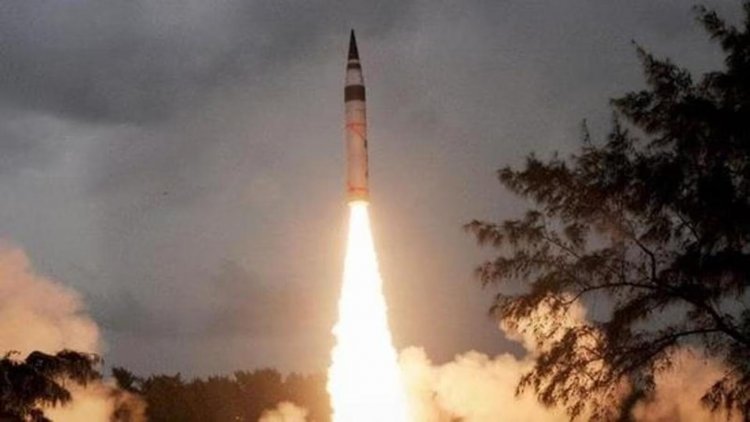Agni-V Ballistic Missile with Multiple Warhead Technology Test Fired
STORIES, ANALYSES, EXPERT VIEWS

In a major technological breakthrough and building in redundancy into the country’s nuclear weapons programme, PM Modi Monday announced the successful test firing of Agni-V ballistic missile with Multiple Independently Targetable Re-entry Vehicle (MIRV) technology by the Defence Research and Development Organisation (DRDO) under ‘Mission Divyastra'. The MIRV technology means a single missile can carry multiple warheads.
The flight test named ‘Mission Divyastra’ was carried out from Dr A. P. J. Abdul Kalam Island in Odisha, DRDO said in a statement adding, “Various telemetry and radar stations tracked and monitored multiple re-entry vehicles. The mission accomplished the designed parameters.”
Noting that with this test India has joined the select group of nations who have MIRV capability, Defence Minister Rajnath Singh too joined the PM in congratulating team DRDO.
The technology: This technology will ensure that a single missile can deploy multiple war heads at different locations, Government sources said noting that with ‘Mission Divyastra’, Government sources said. “This system is equipped with indigenous avionics systems and high accuracy sensor packages, which ensured that the re-entry vehicles reached the target points within the desired accuracy. The capability is an enunciator of India’s growing technological prowess,” sources said. “The project director is a woman and has significant women contribution.”
Agni-V: The maiden flight test of Agni-V, India’s longest range ballistic missile with a “range of more than 5000 kms”, writes Dinakar Peri (Senior Assistant Editor • The Hindu) “was conducted in April 2012 and has since been tested multiple times. It has also been canistered, which improves ease of handling and operation. Agni-V uses a three-stage solid fuelled engine and is capable of striking targets at ranges of over 5,000 Kms and can reach most parts of China. DRDO officials had stated over the last several years that MIRV tech was under development.
Agni series of missiles constitute the backbone of India’s nuclear weapons delivery which also include the Prithvi short range ballistic missiles and fighter aircraft. India has also completed its nuclear triad and operationalised its second strike capability, with indigenously built nuclear ballistic missile submarines now undertaking deterrence patrols.
In March 2019, DRDO had demonstrated Anti-Satellite (ASAT) capability under Mission Shakti by destroying a live orbiting satellite in low earth orbit of around 300 km with a new three-stage interceptor missile in a “Hit to Kill” mode.
A significant leap forward
The test-firing of the Agni-V ballistic missile with MIRV (multiple independently targetable re-entry vehicle) technology, writes The Tribune “marks a significant leap forward for the nation’s defence capabilities. Mission Divyastra, the culmination of years of dedicated efforts by the Defence Research and Development Organisation, showcases India’s growing technological prowess in the global arena. The project, being helmed by a woman director, Sheena Rani, highlights the country’s strides towards gender inclusivity in science and technology.
“The strategic breakthrough has made India one of the six nations possessing the sophisticated MIRV technology. Wedged between nuclear-armed China and Pakistan, the nation has demonstrated its ability to develop cutting-edge defence systems that are on a par with those of major global powers. This technology enables the forces to deploy multiple warheads on missiles, introducing a new level of flexibility and resilience in India’s nuclear arsenal….India’s MIRV push can serve as a powerful deterrent against potential adversaries, reaffirming its resolve to defend its sovereignty and national interests.
“Amid current geopolitical tensions, the country’s enhanced deterrence capabilities can act as a counterbalance to emerging threats, thereby contributing to peace and security regionally as well as globally….”
India’s pursuit of MIRVs: the China factor
While this technological achievement is part of the long march India’s nuclear deterrence capabilities have made since 1988, but as strategic weapons experts Hans Kristensen and Matt Korda note, “it also opens the door to new perils. The introduction of MIRVs during the Cold War forced both superpowers to develop enormous stockpiles of warheads, threatening the mutual deterrence that kept them from war.”
However, according to Praveen Swami (contributing editor at ThePrint) “little imagination is needed to understand the context that has driven India’s pursuit of MIRVs. Even though China does not have significant ABM capabilities yet, it has conducted several successful tests of ballistic missile interceptors since 2010. It remains unclear how much progress China has made on other elements of a deployable ABM system, like space-based early warning satellites and high-resolution tracking radar. However, China’s relentless pursuit of ABM technology since the mid-1980s constitutes a threat to India’s deterrent posture.
“Together with MIRVs, the use of decoy warheads, manoeuvring warheads and stealth technologies all offer means to ensure India’s strategic deterrent against China remains robust while keeping costs manageable."
May spur an arms race: In a thoughtful essay, scholars Rajesh Basrur and Jaganath Sankaran note that the case for Indian MIRVs is not as self-evident as it might seem, though. For one, they argue, it is improbable China would be able to overwhelm India’s military in a future war, or pose an existential threat to the country. That means the risk of nuclear war is relatively low. India’s strategic establishment, they suggest, needs to carefully think through what kinds of deterrent capability it needs, rather than draw on Cold War nuclear theology.
Little reason exists, writes Swami “though, to think MIRVs will give China—or India—the strategic security they crave.” 'In the past, increased nuclear capabilities through MIRVing resulted in an accelerated arms competition, rather than increased confidence in deterrence,’ Basrur and Jagannathan observe. The accumulation of warheads by their adversaries will make it ever more tempting for leaders in both countries to reach for the nuclear trigger first.
















